Georgia Public Schools Well-Funded, Despite Claims to the Contrary
Georgia leaders are pushing back on a recent report on education funding in Georgia. The report, from the left-leaning Georgia Budget & Policy Institute (GBPI), claims that Georgia school…

Georgia leaders are pushing back on a recent report on education funding in Georgia. The report, from the left-leaning Georgia Budget & Policy Institute (GBPI), claims that Georgia school districts are ‘billions of dollars behind’ over the last 20 years. What is left unsaid is that actual dollars for education have nearly doubled over that time. The report was used in political attacks on social media and covered elsewhere without offering the full picture of education funding in the state. Other policy experts and legislators say Georgia schools are ahead, not behind, in funding.
Through pandemic-related federal relief funds, Georgia schools have received nearly $6 billion over two years. Kyle Wingfield, President and CEO of the Georgia Public Policy Foundation (GPPF), told The Lion that over that same period, there were across-the-board state budget cuts that reduced education spending by about $350 million per year, totalling $700 million over the years impacted by the pandemic. But with the nearly $6 billion in federal funds and another $229 million of CARES Act funds allocated by the state for teacher retention bonuses, schools appear well ahead. Wingfield added, “There is no indication that districts have had $6 billion in expenditures.”
Georgia allocates about half of its state budget to education (roughly 40% for K-12 and 15% for higher education for fiscal year 2022). K-12 public schools receive other funding from federal and local sources. For example, in the 2020 fiscal year—the latest year for which data is available—Georgia school districts received on average 63% of their funding from the state, 30% from local sources, and 7% from federal sources.
The GBPI report focuses on cuts from the state budget. Wes Cantrell, a Georgia State Representative, told The Lion that these cuts are across-the-board cuts, not specific to education. For example, last year the entire state budget was cut by 10% in anticipation of the economic impact of COVID. However, the state has since restored 60% of what was cut. Effectively, then, education funding from the state was only reduced by 4% due to COVID.
Rep. Cantrell added that there are also concerns generally with how schools are spending their funds. He said, “Disproportionately schools have been increasing spending on administrators and not those in the classroom.” He added that sometimes the best teachers leave the classroom for the higher-paying administrative jobs.
Ben Scafidi, a professor at Kennesaw State University and Senior Fellow at the GPPF, has highlighted what he calls the ‘staffing surge’ in public education, especially increases in non-teaching staff. In his report, he found that from 1992–2015 non-teaching staff growth in Georgia public schools outpaced student enrollment 60% to 48%.
The numbers are even worse across the United States, with non-teaching staff growth outpacing student enrollment growth 47% to 20% from 1992–2015. Scafidi calculates that if non-teaching staff had only increased at the same rate as student enrollment, schools would have saved $34.9 billion. Those savings could cover salary raises to teachers worth $11,000 per year per, or, alternatively, $8,000 education savings accounts for 4 million students. This casts serious doubt on GBPI’s claim that money has been “taken from the state’s children.”
When looking at costs per pupil, Rep. Cantrell noted that private schools are able to get “more bang for their buck.” This is among the reasons he said he supports school choice, giving parents more options. “I think we can do both [offer public and private school choices] better than either, because when you do both, kids have more opportunities to get in the best environment.”
The broader context of education funding in Georgia suggests schools are in fact well-funded. How districts will use those funds in the immediate future, however, is less clear and invites further attention.



